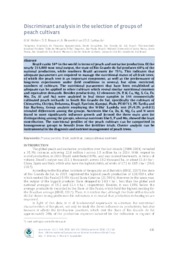Discriminant analysis in the selection of groups of peach cultivars.
Discriminant analysis in the selection of groups of peach cultivars.
Author(s): MELO, G. W. B. de; ROZANE, D. E.; BRUNETTO, G.; LATTUADA, D. S.
Summary: Brazil ranks 14th in the world in terms of peach and nectarine production. Of the nearly 211,000 tons total output, the state of Rio Grande do Sul produces 60% of the national production, while southern Brazil accounts for 75%. This indicates that adequate parameters are required to manage the nutritional status of all fruit trees, of which the peach tree is an important component, as well as the performance of long-term experiments under field conditions in several, but often restricted, numbers of cultivars. The nutritional parameters that have been established as adequate can be applied to other cultivars which reveal similar nutritional contents and equivalent demands. Besides productivity, 12 elements (N, P, K, Ca, Mg, S, Cu, Fe, Mn, Zn, Al and Na) were analyzed in leaf tissue samples in 144 commercially cultivated peach orchards in South Rio Grande do Sul, specifically the cultivars of Chimarrita, Chiripá, Delanona, Eragil, Fascínio, Kampai, Pialo, PS10711, PS-Tardia and São Barbosa. Group analysis employing the Wilks’ Lambda test (F=9.29; p<0.01) revealed differences among the groups. Nutrients like Cu, Zn, K, Mg, Ca and N were found to most significantly influence growth and formed the three main axes for distinguishing among the groups, whereas nutrients like S, P and Mn, showed the least contribution. The nutritional profiles of the peach cultivars can be categorized in homogeneous groups to benefit from the fertilizer trials. Cluster analysis can be instrumental in the diagnosis and nutrient management of peach trees. Keywords: Prunus persica, fruit, nutrition, compositional nutrient
Publication year: 2018
Types of publication: Journal article
Unit: Embrapa Grape & Wine
Keywords: Compositional nutrient, Fruit, Nectarines, Nutrition, Peach cultivars, Peaches, Prunus Persica
Observation
Some of Embrapa's publications are published as ePub files. To read them, use or download one of the following free software options to your computer or mobile device. Android: Google Play Books; IOS: iBooks; Windows and Linux: Calibre.
Access other publications
Access the Agricultural Research Database (BDPA) to consult Embrapa's full library collection and records.
Visit Embrapa Bookstore to purchase books and other publications sold by Embrapa.

